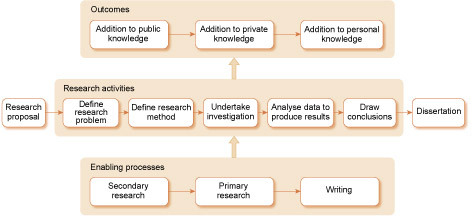1 Preparing for research: the research process
There are different ways of breaking down the research process. Two approaches are considered here. The first consists of six key stages:
- Research question definition – defining the research question.
- Literature review – undertaking a literature review is known as secondary research. It is second-hand research because it is reporting and critically evaluating the work of others. It helps you determine the knowledge gaps and understand your knowledge needs. These in turn guide your research methodology.
- Research methodology – designing the research methodology to collect the evidence required to meet your knowledge needs. In law you may choose to draw upon one or more of the following methods: doctrinal, socio-legal, comparative, international, historical, feminist, critical and transnational.
- Conducting research – this is the primary research. It involves the collection of information for analysis, for example, by devising a questionnaire to interrogate sources you have identified through secondary research or through talking to experts in the field. Perhaps counterintuitively, you will undertake the secondary research before the primary research! Most legal research will be desk based and involve the interrogation of existing materials, for example, legislation, regulation, scholarly articles and official reports.
- Analysing the results – this is when you consider what your findings tell you.
- Conclusions and recommendations – at this stage you will identify the major learning from your research and make some recommendations based on your results.
Figure 1 shows a second approach to the research process. It divides the process into three stages: outcomes, research activities and enabling processes. The top flow diagram shows the outcomes of the research process, namely public, private and personal knowledge. The middle flow diagram shows the research activities. The bottom flow diagram identifies the process through which the research activities are enabled or facilitated.
The difference between public and private knowledge is that public knowledge is commercially published and therefore available to all, whereas private knowledge is restricted to the organisation or institution that commissioned the research. As such, it becomes ‘grey literature’ where the purpose of generating the knowledge is not primarily for publication.
This overview of the research process makes it seem quite straightforward. In reality it is likely to feel chaotic at times and possibly more stressful than the overview suggests. At the beginning you can feel confused, tentative and sometimes unsettled. It is important to have faith in yourself and believe that your research question or aim will become clearer the more focused work you do and the more critical decisions you take; this is normal. It is also something that should be captured explicitly in your research diary; how you interrogated this source and honed that concept (the use of a research diary is discussed in Section 2). This helps you to understand the debates that underpinned your research and the struggles with critical decisions that you took along the way; in turn, it enables you to communicate this when writing your research project. It also demonstrates the logic of what has been done and how it has been concluded.

